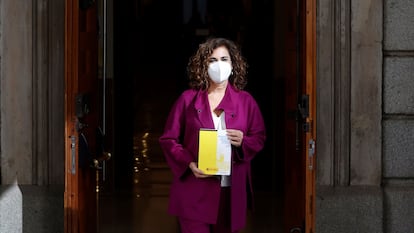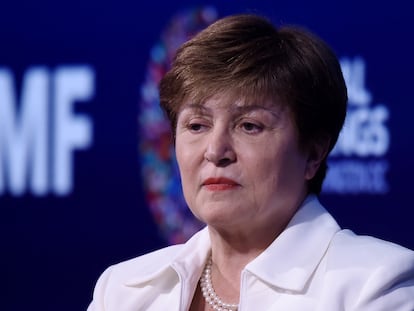More cash for regions, defense, science: Spanish government details expansive budget plan
The document includes an 11.5% rise in funding for Catalonia, viewed as a bid to secure parliamentary support from Catalan separatist lawmakers

Details of the draft budget that the center-left government of Pedro Sánchez presented to Spanish parliament on Wednesday show a record-setting public-spending program for 2022 thanks largely to an influx of European funds to mitigate the effects of the coronavirus pandemic.
The leader of the Socialist Party (PSOE), who heads a minority government with junior partner Unidas Podemos, is hoping to attract parliamentary support for an expansive budget aimed at fuelling the recovery following a record contraction of the economy last year. The spending plan includes more than €27 billion from EU funds that will go toward defense, industry, energy, science and infrastructure projects.
Regional spending
Overall, the southern region of Andalusia will attract the most funds, €2.27 billion, followed by Catalonia with €2.23 billion, the Valencia region with €1.21 billion and Madrid with €1.15 billion. For the latter region, this amount represents a 7.9% drop in investment. The Basque Country will also receive 4.47% less than last year (€489.56 million).
For Catalonia, the €2.23 billion represents an 11.5% rise from the previous budget allocation. This figure also approximately reflects the economic weight of Catalonia in the national economy – 19% of gross domestic product (GDP), according to the National Statistics Institute – and it honors a historical demand by Catalan authorities. Just like last year, the central government is seeking support from Catalan separatist lawmakers inside Spanish parliament to make sure the budget gets passed.
A full €1.3 billion has been earmarked to improve Catalonia’s commuter railroad network, Rodalies, up from €202 million in the 2021 budget. This is viewed as a clear message to the Catalan Republican Left (ERC), whose backing in parliament is crucial. As the Spanish government does not have an absolute majority, it relies on the support of other parties to get key legislation, such as the budget, passed.
But other separatist parties such as Together for Catalonia have noted that these kinds of announcements typically do not match the real investments on the ground. According to the Catalan government, of the €4 billion allocated in the 2008-2015 investment plan for the commuter rail network, only 14% had been invested by the end of 2019.
Overall the government is planning to invest €43.4 billion, some of it in direct investments (€11.2 billion) and the rest in transfers to regional and territorial authorities for them to invest as they see fit. The amount is a significant rise from last year, when €29 billion was allocated for public investments. It is also more than the sum of all the investments made in the years 2012, 2013 and 2014, when Spain was in the grip of the Great Recession sparked by the global financial crisis.
Defense, transportation
Defense, transportation and the environment will get the lion’s share (67.2%) of the investment funds. Some of the stated goals include developing more resilient infrastructures and ecosystems, and advancing toward digitalization.
The Science and Innovation Ministry is also set to receive a historically high amount, €3.8 billion, which Minister Diana Morant said would be used to create opportunities, retain talent and breathe new hope into the scientific community following years of underfunding, precarious working conditions and inefficient bureaucracy.
Social Security system
The Social Security system accounts for one of the largest expenditures in the 2022 budget. Of the €181 billion allocated to the social safety net, €171 billion will go to pay pensions, representing a 4.8% rise from last year. Contributory pensions – those that require a certain number of years of contributions in order to be eligible – will represent nearly 40% of all social spending. They include payments for retirees, widows, people with disabilities, orphans and dependents.
Public salaries
The 2022 budget plan has kept the allowance for members of the Spanish royal family at €8.43 million, the same as last year. King Felipe VI is free to distribute this amount at his discretion, although the website of the Royal Household details that Felipe VI receives €253,850, Queen Letizia €139,610 and former queen Sofía, Felipe’s mother, €114,240. Former king Juan Carlos I used to receive around €160,000, but Felipe VI withdrew his allowance in March 2020 following a tax haven scandal.
Members of the Cabinet will enjoy a 2% salary rise, just like Spain’s three million public servants. According to the draft accounts, Prime Minister Pedro Sánchez will earn €86,542.08 a year.
More tax revenue
Although economic output and consumption will still take time to recover from the crisis, tax revenues are doing unexpectedly well. According to the draft budget, the state will this year collect nearly €215 billion, which is €2.1 billion more than in 2019. This means that it has made up for all the lost revenue in just one year, compared with seven years after the previous crisis.
This rapid rise can be explained in part by the so-called “ERTE” furlough scheme, which helped maintain household incomes during the coronavirus pandemic, as well as rampant inflation, the increase in government workers, the drop in low-wage jobs that pay less in taxes, the growing use of credit cards over cash and the switch to the formal economy by individuals wishing to benefit from Covid-related subsidies, among other reasons.
Tu suscripción se está usando en otro dispositivo
¿Quieres añadir otro usuario a tu suscripción?
Si continúas leyendo en este dispositivo, no se podrá leer en el otro.
FlechaTu suscripción se está usando en otro dispositivo y solo puedes acceder a EL PAÍS desde un dispositivo a la vez.
Si quieres compartir tu cuenta, cambia tu suscripción a la modalidad Premium, así podrás añadir otro usuario. Cada uno accederá con su propia cuenta de email, lo que os permitirá personalizar vuestra experiencia en EL PAÍS.
¿Tienes una suscripción de empresa? Accede aquí para contratar más cuentas.
En el caso de no saber quién está usando tu cuenta, te recomendamos cambiar tu contraseña aquí.
Si decides continuar compartiendo tu cuenta, este mensaje se mostrará en tu dispositivo y en el de la otra persona que está usando tu cuenta de forma indefinida, afectando a tu experiencia de lectura. Puedes consultar aquí los términos y condiciones de la suscripción digital.
More information
Últimas noticias
Maduro pleads not guilty before the federal court in New York: ‘I am still the president of Venezuela’
A new test can detect Alzheimer’s from a finger prick
UN team enters Sudanese city of El Fasher after paramilitary massacre: ‘It’s like a ghost town’
A recipe for resistance: Indigenous peoples politicize their struggles from the kitchen
Most viewed
- Gilles Lipovetsky: ‘If you want to live better and fall in love, take Prozac, don’t look to philosophy’
- Alain Aspect, Nobel laureate in physics: ‘Einstein was so smart that he would have had to recognize quantum entanglement’
- Alvin Hellerstein, a 92-year-old judge appointed by Bill Clinton, to preside over Maduro’s trial in New York
- Why oil has been at the center of Venezuela-US conflicts for decades
- Maduro’s downfall puts China’s relationship with Venezuela to the test









































